Economic Impact of Industrial and Logistics Parks

Infrastructural development propels economic development. The same is true for industrial warehouses, as their influence extends much beyond their immediate surroundings, with the capacity to boost regional economies, generate employment opportunities, and even promote community growth. We examine in more detail how these centres of warehousing are subtly influencing our economic environment.
Creating Job Opportunities
The most obvious and significant contribution that industrial parks make is creating innumerable jobs. They generate direct employment opportunities by offering a wide range of positions in manufacturing, logistics, management, and support services. When workers find well-paying, steady jobs, local consumer spending and overall economic activity are boosted.
But the benefits don’t stop there. An industrial and logistics park’s existence also creates a number of indirect jobs in other services and sectors that are codependent on warehousing and logistics. Warehouse developers and operators routinely need the support of service sectors such as transportation providers, maintenance workers, and local suppliers. There is also a need for skilled and semi-skilled workers on a regular basis. And these service providers require their own set of handymen to keep their services running as well.
Supporting Local Businesses
Industrial and logistics parks are powerful engines for local businesses to thrive. Industrial and logistics activities bring about an influx of related businesses and the necessary workers which bring about a surge in all kinds of economic activities. Local businesses such as retail shops, restaurants, and hospitality services start seeing a rise in patronage as the park’s population grows. This frequently encourages the formation of new business partnerships and innovative entrepreneurial pursuits.
Attracting Investments
Industrial and logistics parks are magnets for both national and international investments. Their well-planned infrastructure, strategic locations, and comprehensive facilities align with businesses looking for new operational bases. As per a Knight Frank report, approximately 77% of private equity (PE) players expressed positive sentiments about continued participation in creating new warehousing assets in India. The year 2023 witnessed a noteworthy surge in private equity investment for warehousing, reaching $1.9 billion. This trend is continuing with warehousing taking center stage in Q2 2024 accounting for 61% of the total record-breaking $2.5 billion investment in real estate in India, according to a recent Colliers report. Increasing investment leads to the expansion of businesses, growth of industrial hubs and nurtures a vibrant business environment.

Boosting Infrastructure Development
A thriving industrial warehouse park often prompts infrastructure improvements, such as the development of roads, utilities, and other major transportation networks necessary to service the premises and make them efficient. The corporate social responsibility initiatives of warehouse developers and their customers can also lead to an upliftment of the environment in the form of rejuvenation of water bodies and landscape and retrofitting of public areas with modern amenities. These enhancements not only benefit the businesses within the park—by supporting them in achieving their ESG goals and garnering consumer goodwill—but also improve the overall business climate, making the region more attractive for further investments and developments.
Community Development
A trickledown effect of the utility and infrastructure development is felt by the local society as well. Improved infrastructure and job availability fosters community growth and nurtures agency among its individuals, helping enhance their living standards, improving their accessibility and widens their horizons.
Beyond physical infrastructure, industrial and warehousing parks often engage in community development programs and initiatives. These efforts can include educational and skill development opportunities for local residents, preparing them for the demands of the modern economy. For instance, an industrial park might partner with local educational institutions to offer vocational training programs, teaching individuals the skills needed for employment within the park but also beyond at times. This not only helps create a skilled workforce but also provides these residents with pathways to better jobs and improved livelihoods.
Similarly, warehouse developers and operators can support community development by investing in social infrastructure. This could involve building community centres, educational institutions, healthcare facilities, or recreational spaces, which enhance the quality of life for residents.
This cycle of investment and development fuels the economic growth of the region. Activities like this position the area as a prime destination for other business ventures to set up their footprint there as well. And their entry fosters more development, keeping the cycle running.